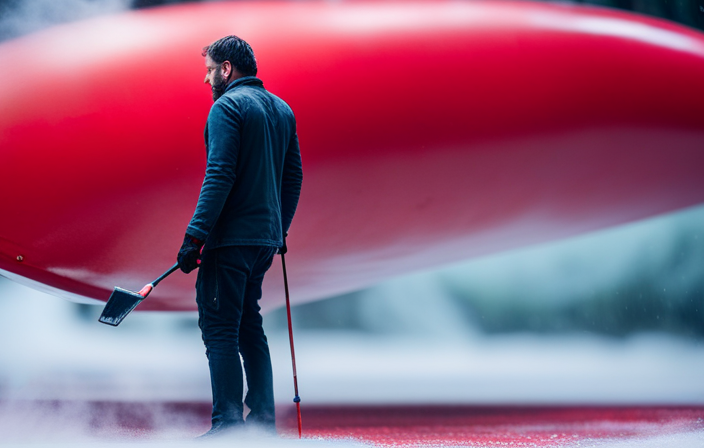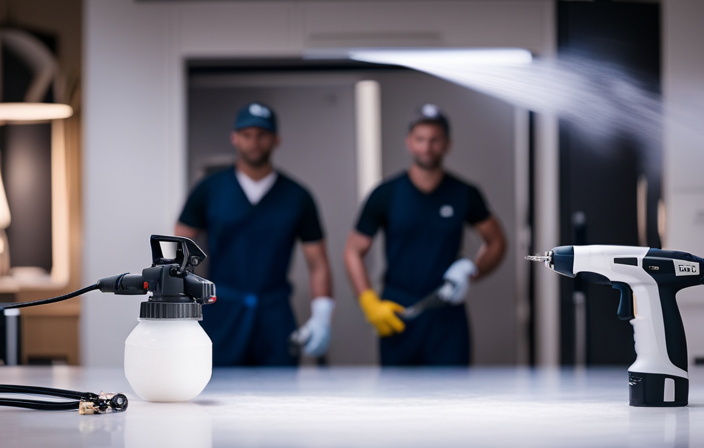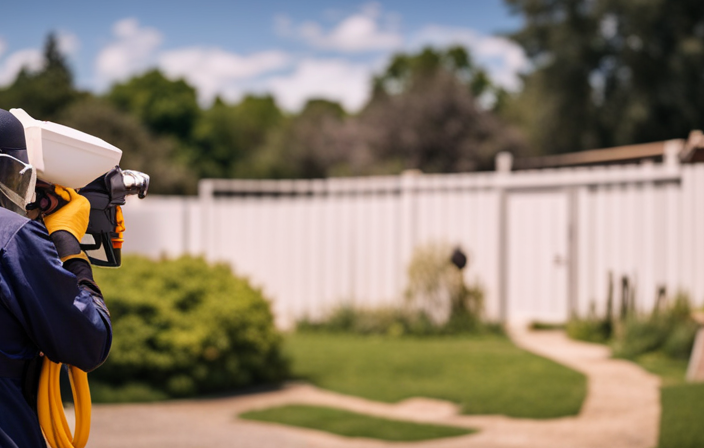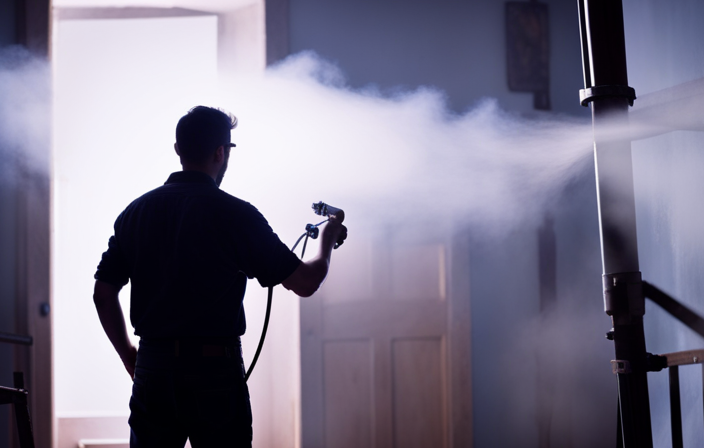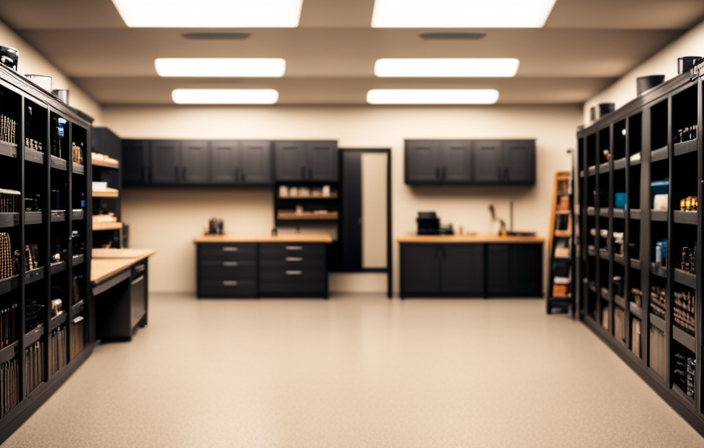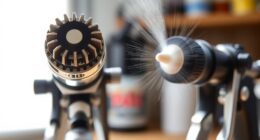Painting a boat may appear daunting, but with the right tools and techniques, it can turn into a rewarding and satisfying project. In this article, I will guide you through the process of painting boats using an airless sprayer.
With its efficiency and precision, the airless sprayer is a game-changer in the world of boat painting.
First, we will discuss the importance of preparing your boat for painting, ensuring a smooth and long-lasting finish.
Then, I will help you choose the right paint and equipment that are compatible with the airless sprayer.
Practice is key, so I will provide you with tips to become comfortable with using the sprayer before diving into the actual painting process.
By the end of this article, you will have all the necessary knowledge to paint your boat flawlessly, taking proper care of the sprayer and giving it the finishing touches it deserves.
So, let’s dive in and transform your boat into a work of art!
Key Takeaways
- Properly prepare the surface by sanding and removing imperfections before painting with an airless sprayer
- Choose the right marine-grade paint for durability and adhesion to achieve a professional-looking finish
- Practice spraying technique with an airless sprayer for even application and to avoid brush strokes and roller marks
- Allow each coat to dry completely before applying the next one and take the time to properly maintain and troubleshoot the sprayer for a successful paint job.
Prepare Your Boat for Painting
You’ll need to properly clean and sand your boat before painting it with an airless sprayer. Boat cleaning is an essential step to ensure the paint adheres properly and lasts longer.
Start by removing any loose dirt, debris, or old paint using a pressure washer or a scrub brush. Pay attention to hard-to-reach areas like the hull, seams, and corners.
Next, use a marine-grade detergent and a sponge to thoroughly clean the surface, removing any grease, oil, or other contaminants.
Once the boat is clean, it’s time to sand. Use a fine-grit sandpaper or a sanding block to smooth out any rough spots, scratches, or old paint. Remember to sand in the direction of the grain and always wear protective goggles and a mask.
With a properly cleaned and sanded boat, you’re now ready to move on to choosing the right paint and equipment for the job.
Choose the Right Paint and Equipment
When selecting the appropriate materials and machinery, it’s crucial to ensure compatibility and efficiency for a flawless application. Choosing the right paint color is essential to achieve the desired aesthetic for your boat. Consider factors such as UV protection, durability, and ease of maintenance when making your selection. Additionally, proper ventilation during painting is crucial to ensure the safety of yourself and others. Adequate airflow helps to dissipate fumes and prevent the buildup of harmful chemicals. To help you make an informed decision, refer to the table below for a comparison of different paint types and their characteristics.
| Paint Type | UV Protection | Durability | Maintenance |
|---|---|---|---|
| Epoxy | High | Excellent | Low |
| Polyurethane | Medium | Good | Medium |
| Antifouling | Low | Good | High |
With the right paint color and proper ventilation in mind, you can now move on to practicing using the airless sprayer to achieve professional results.
Practice Using the Airless Sprayer
Before you start painting with an airless sprayer, it’s important to familiarize yourself with the controls. Take the time to read the manual and understand how each button and knob works.
Next, adjust the spray pattern and pressure to achieve the desired coverage and finish. Start by testing the sprayer on a scrap surface to ensure the settings are correct before moving on to the actual painting.
Familiarize Yourself with the Controls
Get a grip on the controls of the airless sprayer to master the art of painting boats. Familiarize yourself with the controls to ensure a smooth and efficient painting process.
Start by understanding the main components of the sprayer, such as the trigger, pressure control knob, and spray tip. The trigger is used to control the flow of paint, while the pressure control knob adjusts the pressure at which the paint is sprayed. It’s important to find the right balance between pressure and flow rate to achieve an even and consistent paint application.
Additionally, learn how to properly hold the sprayer and maintain a steady hand to avoid any accidental paint spills or splatters.
By familiarizing yourself with the controls and mastering the proper technique, you’ll be ready to adjust the spray pattern and pressure, which we’ll discuss in the next section.
Adjust the Spray Pattern and Pressure
Once you’ve mastered the controls, you can effortlessly manipulate the spray pattern and pressure to achieve a flawless finish.
Adjusting the spray pattern is crucial to ensure an even coating on the boat’s surface. By rotating the nozzle, you can switch between horizontal, vertical, and round patterns, allowing you to customize the application according to the shape of the boat.
Controlling paint flow is equally important to avoid over-spraying or under-spraying. You can regulate the pressure using the sprayer’s pressure control knob. Increasing the pressure will result in a higher paint flow, while decreasing it will reduce the flow. It’s essential to find the right balance to achieve optimal coverage.
Now that we’ve mastered the spray pattern and pressure adjustments, let’s move on to the next step and test the sprayer on a scrap surface.
Test the Sprayer on a Scrap Surface
Try out the sprayer on a scrap surface to see the amazing results you can achieve. Testing techniques are crucial to ensure that your airless sprayer is working optimally before starting the actual painting process.
To begin, make sure the sprayer is properly assembled and primed with the paint you’ll be using. Adjust the spray pattern and pressure settings according to the manufacturer’s instructions.
Start by spraying a small area on the scrap surface, holding the sprayer at a consistent distance and angle. Observe the spray pattern for any irregularities or inconsistencies. If you notice any issues, such as uneven coverage or excessive overspray, troubleshoot by adjusting the pressure or cleaning the nozzle.
Once you’re satisfied with the spray pattern and coverage, you can confidently start painting your boat, knowing that the sprayer is functioning correctly.
Start Painting
To begin painting with an airless sprayer, first, you’ll wanna grab your trusty sprayer and dive right in, feeling the thrill of transforming your boat with a single swoosh of the nozzle.
Before you start, it’s important to know some tips for achieving a smooth finish. Firstly, make sure to hold the sprayer at a consistent distance from the boat, usually around 12 inches. This will ensure an even application of paint.
Additionally, move the sprayer in a steady, controlled motion to avoid any drips or uneven coverage. As for common mistakes to avoid, be sure not to overspray or apply too much paint at once, as this can lead to runs and sagging.
Lastly, always clean the sprayer thoroughly after each use to maintain its performance and longevity. Taking proper care of the sprayer is essential to ensure it remains in top condition for future projects.
Now, onto how to take proper care of the sprayer…
Take Proper Care of the Sprayer
Make sure you give your trusty sprayer some TLC to keep it humming like a well-oiled machine, ensuring smooth sailing for all your future projects. Maintaining spray equipment is crucial to avoid clogs and blockages that can disrupt your painting process.
Here are three key steps to take proper care of your airless sprayer:
- Clean the sprayer thoroughly after each use to remove any residual paint or debris that may cause blockages.
- Regularly inspect the sprayer’s filters and replace them if they become clogged or damaged.
- Lubricate the sprayer’s moving parts, such as the piston rod and packings, to keep them in optimal condition and prevent wear.
By following these maintenance practices, you can ensure that your sprayer remains in top-notch shape, ready for your next painting project.
Now, let’s move on to applying additional coats if needed.
Apply Additional Coats if Needed
Ensure your project’s perfection by applying additional coats if necessary, allowing the true beauty of your work to shine through.
When using an airless sprayer to paint boats, it’s important to remember that achieving a smooth finish may require multiple coats. Before applying additional coats, make sure the previous coat is completely dry and free from any imperfections.
Inspect the surface for any areas that may need touch-ups or additional coverage. Adjust the sprayer settings to ensure an even application and overlap each pass by about 50% to avoid streaks or unevenness.
Apply the additional coats using the same technique as before, making sure to maintain a consistent pressure and distance from the boat. Once you’ve achieved the desired coverage and smoothness, you can move on to the finishing touches that’ll enhance the final look of your boat.
Finishing Touches
Don’t forget, adding those final touches will really make your boat stand out from the rest. Here are some refinishing techniques to enhance the overall look of your newly painted boat:
-
Varnish Application: Apply a thin and even coat of marine-grade varnish to protect the paint and provide a glossy finish. Use a high-quality brush or a foam roller for smooth application. Ensure the boat is completely clean and dry before starting.
-
Sanding: After each coat of varnish, lightly sand the surface with fine-grit sandpaper to remove imperfections and create a smooth finish. Wipe away the dust using a tack cloth before applying the next coat.
-
Buffing: Once the final coat of varnish is applied and fully cured, use a buffing compound and a buffing pad to bring out a brilliant shine. This step will remove any remaining blemishes and enhance the boat’s appearance.
By following these refinishing techniques, your boat will look impeccable. Now, you can enjoy your newly painted boat, ready to take on the waters with pride.
Enjoy Your Newly Painted Boat
After completing the painting process with an airless sprayer, I can’t help but admire the professional-looking finish of my newly painted boat. The smooth and even application of paint gives my boat a polished and flawless appearance that rivals that of a professional paint job.
I take great pride in my DIY painting skills, knowing that I was able to achieve such a high-quality result on my own. Now, I can’t wait to show off my boat’s new look to others and receive compliments on the stunning transformation I’ve achieved.
Admire the Professional-Looking Finish
Appreciate the polished appearance achieved with an airless sprayer when painting boats. Professional boat painting techniques, coupled with the use of an airless sprayer, allow you to achieve a smooth and glossy finish that rivals the work of a professional.
The high-pressure spray evenly distributes the paint, ensuring a flawless application. The fine mist produced by the sprayer atomizes the paint particles, resulting in a professional-looking finish that is free from brush strokes or roller marks.
The airless sprayer also allows for greater control and precision, allowing you to easily reach difficult areas and tight corners. Admire the flawless surface of your boat, as the airless sprayer effortlessly transforms it into a work of art.
Take pride in your DIY painting skills as you move on to the next step, knowing that your boat now boasts a stunning, professional finish.
Take Pride in Your DIY Painting Skills
You’ll be amazed at the level of craftsmanship you’ll achieve with your own DIY painting skills. Not only will you save money by tackling your own boat painting projects, but you’ll also improve your painting techniques along the way.
Here are four essential tips to help you elevate your skills to the next level:
-
Proper surface preparation: Ensure a clean and smooth surface by sanding and removing any old paint or imperfections.
-
Choose the right paint: Select a high-quality marine-grade paint that’s specifically designed for boats.
-
Master the airless sprayer: Practice your spraying technique to achieve an even and professional finish.
-
Practice patience: Allow each coat to dry completely before applying the next one for the best results.
With these tips, your DIY painting skills will shine, and you’ll be ready to show off your boat’s new look to others.
Show Off Your Boat’s New Look to Others
Impress your peers with the stunning transformation of your boat’s appearance. By utilizing the right boat painting techniques, you can achieve professional-looking results that will leave everyone in awe.
However, it’s important to avoid common boat painting mistakes that can undermine your efforts. One key technique is to ensure proper surface preparation, including cleaning, sanding, and priming. This will ensure that the paint adheres well and lasts longer.
Additionally, using the right type of paint and applying it evenly with an airless sprayer will give your boat a smooth and flawless finish. Remember to follow the manufacturer’s instructions and wear appropriate safety gear throughout the process.
With these tips in mind, you can confidently showcase your boat’s new look to others.
Transitioning into the next section about troubleshooting and tips, let’s explore some common challenges that may arise during the boat painting process and how to overcome them.
Troubleshooting and Tips
To make your boat painting experience smoother, try incorporating these troubleshooting and helpful tips.
- Ensure that the airless sprayer is properly cleaned and maintained before starting the painting process.
- Check the viscosity of the paint to ensure it’s suitable for spraying and adjust the paint thickness if needed.
Start with a test spray on a small area to ensure the sprayer is working properly and the paint is being applied evenly.
Maintain a consistent distance between the sprayer and the boat surface to avoid uneven application. Keep a steady hand and use slow, even strokes to achieve a smooth finish.
By following these troubleshooting techniques and avoiding common mistakes, you can achieve a professional-looking paint job on your boat. Now, let’s move on to discussing maintenance and repainting.
Maintenance and Repainting
Don’t fret, mate! Maintaining and giving your vessel a fresh coat is all part and parcel of being a boat owner.
When it comes to boat painting techniques, using an airless sprayer can provide a smooth and efficient finish. However, before you start painting, make sure to choose the right primer for your boat’s surface. A good primer will ensure better adhesion and longevity of the paint.
For fiberglass boats, use a primer specifically designed for fiberglass surfaces. If you have a metal boat, opt for a primer that provides rust protection.
It’s also important to properly prepare the surface by cleaning and sanding it before applying the primer. This will help the paint adhere better and result in a more professional-looking finish.
So, get your boat looking shipshape by following these maintenance and repainting tips!
Frequently Asked Questions
Is it necessary to wear protective clothing and equipment while using an airless sprayer?
Yes, it is necessary to wear protective clothing and equipment when using an airless sprayer. Safety precautions such as goggles, gloves, a respirator, and coveralls should be worn to protect against potential hazards and ensure personal safety.
Can I use the same airless sprayer for different types of paints?
Yes, you can use the same airless sprayer for different types of paints! It’s a versatile tool that requires proper airless sprayer maintenance and following best practices for airless sprayer use.
How long should I wait between applying coats of paint?
To achieve a smooth finish with an airless sprayer, it is important to wait for the first coat of paint to dry completely before applying the next coat. This ensures proper adhesion and prevents any imperfections in the final finish. Additionally, choosing the right paint for boat painting is crucial in obtaining a durable and long-lasting result.
What should I do if the paint starts to clog the sprayer nozzle?
If the paint starts to clog the sprayer nozzle, I would first stop spraying and turn off the sprayer. Then, I would carefully remove the nozzle and clean it thoroughly to remove any paint buildup. This troubleshooting step ensures optimal performance of the airless sprayer.
How often should I clean and maintain my airless sprayer to ensure its longevity?
To ensure the longevity of your airless sprayer, it is crucial to clean and maintain it regularly. Cleaning frequency and maintenance techniques will vary depending on usage, but a general rule is to clean after each use and perform routine maintenance every few months.
Conclusion
So there you have it, folks! Painting your boat with an airless sprayer may seem like a daunting task, but with the right preparation, equipment, and practice, it can be a breeze.
Just remember to choose the right paint and take care of your sprayer properly. And don’t forget those finishing touches!
Now you can sit back, relax, and enjoy your newly painted boat. And if you encounter any issues along the way, don’t fret. Troubleshooting and maintenance are all part of the fun.
Happy painting!
